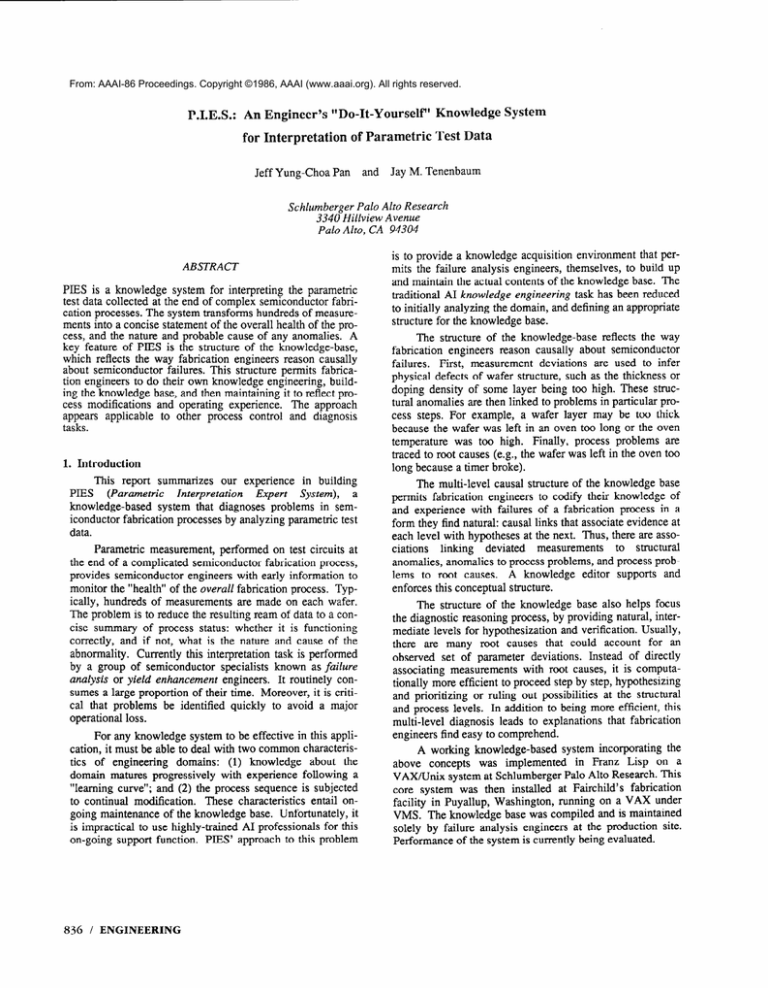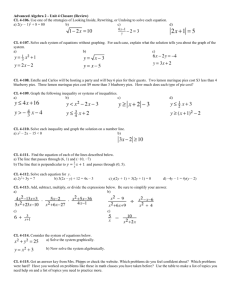
From: AAAI-86 Proceedings. Copyright ©1986, AAAI (www.aaai.org). All rights reserved.
P.I.E.S.:
An Engineer’s
“Do-It-Yourself’
for Interpretation
Knowledge System
of Parametric Test Data
Jeff Yung-Choa Pan
and
Jay M. Tenenbaum
Schlumberger Palo Alto Research
3340 Hillview Avenue
Palo Alto, CA 94304
ABSTRACT
PIES is a knowledge system for interpreting the parametric
test data collected at the end of complex semiconductor fabrication processes. The system transforms hundreds of measurements into a concise statement of the overall health of the process, and the nature and probable cause of any anomalies. A
key feature of PIES is the structure of the knowledge-base,
which reflects the way fabrication engineers reason causally
about semiconductor failures. This structure permits fabrication engineers to do their own knowledge engineering, building the knowledge base, and then maintaining it to reflect process modifications and operating experience. The approach
appears applicable to other process control and diagnosis
tasks.
1. Introduction
This report summarizes our experience in building
PIES (Parametric
Interpretation
Expert
System),
a
knowledge-based system that diagnoses problems in semiconductor fabrication processes by analyzing parametric test
data.
Parametric measurement, performed on test circuits at
the end of a complicated semiconductor fabrication process,
provides semiconductor engineers with early information to
monitor the “health” of the overall fabrication process. Typically, hundreds of measurements are made on each wafer.
The problem is to reduce the resulting ream of data to a concise summary of process status: whether it is functioning
correctly, and if not, what is the nature and cause of the
abnormality. Currently this interpretation task is performed
by a group of semiconductor specialists known as failure
analysis or yield enhancement engineers. It routinely consumes a large proportion of their time. Moreover, it is critical that problems be identified quickly to avoid a major
operational loss.
For any knowledge system to be effective in this application, it must be able to deal with two common characteristics of engineering domains: (1) knowledge about the
domain matures progressively with experience following a
“learning curve”; and (2) the process sequence is subjected
to continual modification. These characteristics entail ongoing maintenance of the knowledge base. Unfortunately, it
is impractical to use highly-trained AI professionals for this
on-going support function. PIES’ approach to this problem
836
/ ENGINEERING
is to provide a knowledge acquisition environment that permits the failure analysis engineers, themselves, to build up
and maintain the actual contents of the knowledge base. The
traditional AI knowledge engineering task has been reduced
to initially analyzing the domain, and defining an appropriate
structure for the knowledge base.
The structure of the knowledge-base reflects the way
fabrication engineers reason causally about semiconductor
failures. First, measurement deviations are used to infer
physical defects of wafer structure, such as the thickness or
doping density of some layer being too high. These structural anomalies are then linked to problems in particular process steps. For example, a wafer layer may be too thick
because the wafer was left in an oven too long or the oven
temperature was too high. Finally, process problems are
traced to root causes (e.g., the wafer was left in the oven too
long because a timer broke).
The multi-level causal structure of the knowledge base
permits fabrication engineers to codify their knowledge of
and experience with failures of a fabrication process in a
form they find natural: causal links that associate evidence at
each level with hypotheses at the next. Thus, there are associations linking
deviated measurements
to structural
anomalies, anomalies to process problems, and process problems to root causes. A knowledge editor supports and
enforces this conceptual structure.
The structure of the knowledge base also helps focus
the diagnostic reasoning process, by providing natural, intermediate levels for hypothesization and verification. Usually,
there are many root causes that could account for an
observed set of parameter deviations. Instead of directly
associating measurements with root causes, it is computationally more efficient to proceed step by step, hypothesizing
and prioritizing or ruling out possibilities at the structural
and process levels. In addition to being more efficient, this
multi-level diagnosis leads to explanations that fabrication
engineers find easy to comprehend.
A working knowledge-based system incorporating the
above concepts was implemented in Franz Lisp on a
VAX/Unix system at Schlumberger Palo Alto Research. This
core system was then installed at Fairchild’s fabrication
facility in Puyallup, Washington, running on a VAX under
VMS. The knowledge base was compiled and is maintained
solely by failure analysis engineers at the production site.
Performance of the system is currently being evaluated.
2. Background
2.1. About Semiconductor
Test
Fabrication
and Parametric
Semiconductor devices are manufactured in two
phases, as shown in figure 1: Wafers are first fabricated in
batches (known as “lots”) in the controlled environment of
a clean-room; the wafers are then cut into “dice” which are
individually packaged and tested. Parametric testing is performed on lots at the conclusion of the fabrication process,
just before the wafers are cut.
The recipe for a modem semiconductor product typically contains more than 100 process steps. Each step is a
chemical/physical
interaction between a wafer and its
environment under precise control of process equipment
oxidation,
etching,
ion-implantation).
(e.g., epitaxy,
Although the result of each individual process step is monitored by a so called in-process test (such as measuring the
thickness of an oxide layer) to make sure that it is within
tolerance, the combined effect of these process steps cannot
be verified until complete execution of the recipe. Hence,
the need for parametric testing.
When abnormal measurements of some key parameters are detected, the wafer is rejected and sent for failure
analysis, accompanied by a complete test record of the lot.
The job of the failure analysis engineer is to diagnose the
process step(s) responsible for the failure and take
appropriate corrective action. The daily workload of a
failure analysis engineer thus depends on the number of
rejected wafers during the previous day, and the difficulties
of those cases, each of which takes tens of minutes to hours
to diagnose. A knowledge based system, such as PIES, can
enhance the productivity of a failure analysis engineer in
two ways: fist, it focuses an engineer’s attention by reducing the flood of raw test data to a few likely failure candidates; second, it ensures an objective analysis by providing
a complete and unbiased assessment of the situation.
I<
Semiconductor fabrication was selected as a good
experimental domain to pursue our long term interest in
applying AI technology to manufacturing. The choice was
based on a number of considerations. First, there is high
leverage: because of the high volume (millions of die a
year), small percentage increases in yield can result in considerable increases in profit. Second, the processes are not
always well understood, so that actual operating experience
is critical to achieving acceptable yields. It is important to
be able to codify this experience so that it can be widely
replicated and shared. Third, semiconductor fabrication is
an ideal domain to pursue AI research on qualitative
modeling and reasoning. Due to the ever-changing nature
of fabrication technology, a knowledge system that is
totally dependent on hand-coded, process-specific, taskspecific, experiential knowledge is inefficient to maintain
and difficult to generalize.
Moreover, semicoductor
engineers routinely invoke models of solid-state physics
and silicon processing to explain a problem not encountered previously. To achieve the same level of competence
as a human engineer, we set as a long-term goal to develop
qualitative modeling and reasoning techniques that can
supplement PIES’ experience-oriented knowledge base.
2.2. Shallow-Level
Systems
vs. Deep-Level
Approach to Expert
A conventional way to build an expert system for
diagnosing process faults would be to rely on a knowledge
engineer to capture the experience of fabrication engineers
in the form of if-then or production rules [ 11. An inference
mechanism might then use a forward chaining inference
process [2] to transform an input set of parametric symptoms into a set of possible faults. The approach so
described is sometimes referred to as a shallow-level
approach [3], because its knowledge base records only
aspects of experience acquired from human experts, and
not a model of the domain about which the system is supposed to be an expert. An alternative deep-level approach
would be to perform diagnosis by reasoning with models of
the (semiconductor) domain [4].
FAB LINE OPERATION
i
(in clean rooms)
lOO+process steps
t
I
w
. ,
e,
-c
l
-
Packaging
.
(paromerrk
resr dam)
Figure 1 A Typical Semiconductor Manufacturing Process
APPLICATIONS
/ 837
A shallow-level approach is suitable when experience,
not the exercise of theory, plays the key role in performing
a task. For a fixed problem, a shallow system can be built
in a relative short time, and can be “tuned’ to a high-level
of performance, as demonstrated by MYCIN [5]. However, a shallow-level system will require re-engineering of
its knowledge base whenever there is a change in the
domain.
variations in the fabrication process which, in turn, will
produce physical abnormalities in the wafer structure and
corresponding deviations in parametric measurements associated with that structure. PIES’ diagnosis approach is to
isolate the possible causes of observed symptoms by “reversing” this causal chain level by level, following the
sequence of measurement deviations --> physical structure
The deep-level approach complements the weakness
of the shallow-level system because of its potential to
derive solutions for unanticipated situations from the
underlying principles of the domain. It is particularly
advantageous in engineering-oriented
domains where a
complete or partial domain theory already exists. The progress made in the direction of qualitative modeling and reasoning [6, 7, 8, 41 is promising, but the technique needs
futher development before it can be useful in practice.
The knowledge base in PIES consists of four levels
that correspond directly to those in figure 2. At each level
we enumerate observed failure modes. For example, at the
physical structure level, such modes would include
incorrect thickness or doping density of particular wafer
layers (e.g., the epitaxial layer). At the fabrication process
level, the failure modes would include incorrect temperatures or gas densities during particular process steps (e.g.,
oxidation or ion-implantation).
Rules, provided by the
fabrication engineer, link failure modes at adjacent levels.
Thus, EPI-thickness-high
is associated with abnormally
high temperature during the epitaxial process stage.
PIES’ knowledge base approach falls between shallow
and deep level approaches (semi-deep). It is similar to a
shallow-level system in that it attempts to help domain
experts in formalizing their experience and to apply the
knowledge so acquired in diagnosis. On the other hand, it
explicitly represents the structure of the domain in terms of
multiple causal levels, and uses such conceptual levels to
communicate naturally with domain experts (in both
knowledge acquisition and diagnostic reporting).
3. Approach
3.1. Overview
Figure 2 shows the causal chain through which fabrication failures originate and propagate. The root cause is
either a malfunction in some fabrication equipment, contamination in the source materials or clean-room environment, or a human error. Any of these causes will result in
HUMAN
(Wan.
mix-lot,
OPERATION
ert0t
atip4-ucp,
misdid,etc.)
FABRICATION PROCESS
variations
PHYSICAL SILICON STRUCTURE
abnormalities
PARAMETRIC MEASUREMENTS
deviations
Figure 2 Multi-Level Propagation of Fabrication Failures
838
/ ENGINEERING
abnormalities
--> process variations
--> rootcauses.
Fabrication engineers often find it convenient to
organize their knowledge around specific failure cases,
each corresponding to an observed or expected anomaly in
physical structure. Associated with each such structural
anomaly are a set of expected symptoms (i.e., measurement
deviations) and a set of possible causes (i.e., process
failures).
Diagnosis proceeds as a multi-level hypothesisverification process. Parametric measurements are first
preprocessed to transform them from numeric values to
qualitative ranges (e.g., normal, high, very high). Each
measurement that is abnormal implicates one or more physical structure problems. The expected symptoms associated with each of these hypothesized physical structure
problems are compared against the complete set of abnormal measurements. A score is assigned corresponding to
how well the expected symptoms match the observed ones.
The scores are compared and hypotheses with significantly
lower scores are eliminated from consideration. The same
hypothesis-verification
process is then used to select the
most probable process failures based on the surviving
structural problems. Finally, the root causes are selected
that best explain the highest likelihood process failures.
This iterated hypothesis-verification approach will identify
the primary (i.e., most likely) failures. In many cases, it
will also reveal multiple failures, that may be independent
of, or causally-related to, the primary failure.
The PIES knowledge editor makes it possible for a
fabrication engineer, without AI training, to build and
maintain the knowledge base. It does this by directly supporting PIES’ multi-level case-centered knowledge organization, thereby guiding an engineer to decompose his
knowledge in a way that is both natural for him and
required by PIES. Using the editor, an engineer can focus
on the failure cases at any level. He can create or delete
cases, as well as their associational links to other cases at
the same or adjacent levels in the causal chain. For example, having discovered a new type of physical structure
failure, he can add it to the knowledge base, along with the
expected symptoms and probable causes.
3.2. Knowledge Base
The top level of PIES’ knowledge base is organized
into four explicit causal levels: measurement, physical
As part of the representastructure, process, rootcause.
tional mechanism in PIES, the causal sequence among
those four levels is described by a set of symbolic links,
which are used by both the knowledge editor and the diagnos tic reasoner.
At each causal level, the knowledge base is decomposed into frame-like structures, called failure cases or
cases for short, each encoding knowledge about a type of
failure at that level.
The cases have “slots” for encoding attributes that
describe a particular type of failure. Examples of such
attributes in PIES’ current implementation are: the “popular” name commonly used by domain experts to refer to a
failure case; comments from fabrication engineers about
the failure; and most significantly, four types of associational link which describe how this case is causally related
to other types of failure. Other slots are used in conjunction
with the knowledge base editor (see below) to group failure
cases in ways that users find convenient.
A domain expert’s knowledge about possible causal
connections between two types of failure is represented in
PIES by associational links. A link may be one of two
types: causes or caused-by, and is further distinguished
between intra-level and inter-level, depending on whether
the other failure case it refers to is at the same or a deferent
causal level. Each associational link has an associational
strength, which is a heuristic estimation of the strength of
the causal relationship, and can be one of five quantized
states: must, very-likely, likely, probably, maybe.
As an example, a common failure in a bipolar ISO-Z
process at the physical structure level occurs when an ionimplantation problem alters the distribution of doping in
the base region of a transistor. PIES representation for this
problem, known as BASE-DLSTRIB MUON-deep, is shown
(in its pretty-print form) as the following:
Knowledge about a case of physical structure defect:
BASE DISTRIBUTION deep
**********************************************************
Possible effects at measurement level -1: ((parametric-measurement WElOBETA low) very-likely)
2: ((parametric-measurement RB 1 low) probably)
3: ((parametric-measurement RB2 low) very-likely)
4: ((parametric-measurement WElO-CBO low) probably)
5: ((parametric-measurement SOT2-CBO low) probably)
6: ((parametric-measurement SOT-B-SU very-low) probably)
7: ((parametric-measurement SOTBETAF low) probably)
Possible causes at process level -1: ((BASE-IMPLANT ENERGY high) likely)
2: ((BASE-DRIVE FURNACE-TEMPERATURE high) likely)
3: ((BASE-DRIVE DIFFUSION-TIME long) likely)
Possible causes at SAME physical-structure level -1: ((BASE-OXIDE THICKNESS low) likely)
**********************************************************:
In this example, the failure type of BASE DISTRIBUTION
deep is said to be causally related to other types of failure
at the process level, measurement level, and the physical
structure level itself. As indicated, if it occurs, it may
result in seven types of measurement deviation, but some
of them are more likely to manifest (e.g., WElOBETA)
than others (e.g., RBl).
3.3. Knowledge Editor
The knowledge editor enables domain experts to build
and maintain the PIES knowledge base without on-site help
from AI specialists. Acquiring knowledge directly from
domain experts has several advantages in practice: it
relieves AI specialists from on-site visits and lengthy
knowledge engineering
sessions with domain experts; it
avoids misunderstanding,
and thus mistranslation
of
knowledge from domain experts to AI specialists; and it
allows domain experts to incorporate new experience
quickly into the knowledge base. This last feature makes
the system more suitable than the traditional expert system
approach in dealing with a changing domain.
The primary function of the knowledge editor is to
guide domain experts in codifying their knowledge and
expertise in a form consistent with the PIES knowledge
base. During a knowledge engineering
session, the
knowledge editor first allows the domain expert to focus
his attention on one of PIES causal levels. Within that particular level, the knowledge editor allows the user to maintain his own hierarchy of failure concepts. For example, at
the physical structure level, he may wish to group together
all failures associated with the same wafer layer, and
within any one layer, all failures of a particular type (e.g.,
doping problems). This support of concept hierarchies
helps the expert to organize the many types of failure
known to the knowledge base. The knowledge editor provides its users with easy commands to create and traverse
his hierarchy, to define new failure cases, and subsequently
to fill in or modify the contents (slots) of a failure case. In
summary, the PIES’ knowledge editor guides a domain
expert to decompose his failure-related expertise into the
structure required by PIES’ knowledge base. It ensures that
the knowledge that is codified is both syntactically and
semantically correct.
For example, in a knowledge-engineering
session to
build the knowledge base for diagnosing failures in
Fairchild’s ISO-Z bipolar process, our collaborator at
Fairchild/Puyallup site chose to focus his attention on the
physical structure level. PIES’ editor helped him to organize known cases of physical structure failures into a hierarchy, and allowed him to traverse the hierarchy to a particular case of interest: BASE-DISTRIBUTION-deep,
as
shown in figure 3. To organize what he knew about the
failure, the expert conceptualized relevant causalities centered around BASE-DISTRIBUTION-deep,
as shown in
figure 4. The knowledge editor allowed him to establish
associational links from BASE-DISTRIBUTION-deep
to
other known failure cases at efict level (measurement
level), cause level (process level), and self (physical structure level). The editor allows him to add, delete, or replace
associational links, as necessary.
APPLICATIONS
/ 839
Welcome to FairchikHchlumberger
Parametric Interpretation Expert System
Available Commands are:
<HELP> show new-perspective
up top Mark-Case fill
write-and-quit
exit abort expert beginner reset reset!
display-highlight-on
display-highlight-of
edit write
Enter Command (<CR> for listing of Case-Path) =>> newp
1: measurement 2: physical-structure 3: process 4: root-causes
Enter selection (0 for redisplay, <CR> for physical-structure)
=> 2
Case-Library last modified on Wed Jun 12 11:07: 18 1985
Total of 82 cases from file cphysical.cas> loaded! !
You are now referring to the TOP of physical-structure
1: COLLECTOR 2: EPI 3: ETCHED-SILICON 4: ISO-OX 5: SINK
6: EMITTER 7: BASE 8: FIELD 9: SILICON 10: METAL-l
11: ISO-ISLAND 12: VIA 13: BASE-OXIDE 14: LVCEO-RESISTOR
15: GROUND-TAP 16: GUARD-RING 17: SIDEWALL 18: METAL-2
Enter Command (<CR> for listing of Case-Path) =>> 7
You are now referring to (BASE) of physical-structure
1: EXTRINSIC-Q 2: DISTRIBUTION 3: INTRINSIC-Q
Enter Command (<CR> for listing of Case-Path) =>> 2
You are now referring to (BASE DISTRIBUTION)
1: deep 2: shallow
of physical-structure
Enter Command (<CR> for listing of Case-Path) =>> 1
You are now referring to (BASE DISTRIBUTION deep) of physical-structure
_-----_-----______-_-----~~~--------------______________----------------CASE-NAME: BASE-DISTRIBUTION-deep
at physical-structure
level
Following symptoms at measurement level are to be resulted from this case:
1: ((parametric-measurement WElOBETA low) very-likely)
2: ((parametric-measurement RB 1 low) probably)
3: ((parametric-measurement RB2 low) very-likely)
4: ((parametric-measurement WElO-CBO low) probably)
5: ((parametric-measurement
SOT2-CBO low) probably)
6: ((parametric-measurement
SOT-B-SU very-low) probably)
7: ((parametric-measurement SOTBETAF low) probably)
--s---
Following causes at process level is to result in this case:
1: ((BASE-IMPLANT ENERGY high) likely)
2: ((BASE-DRIVE FURNACE-TEMPERATURE
high) likely)
3: ((BASE-DRIVE DIFFUSION-TIME long) likely)
Following causes at CURRENT physical-structure
1: ((BASE-OXIDE THICKNESS low) likely)
level can result in this case:
Figure 3 A Sample Knowledge Engineering Session under PIES’ Knowledge Editor
840
/ ENGINEERING
BASEOXIDE THICKNESS low
+
WElOBETA low
BASE DISTRIBUTION
/BASE-IMPLANT
deep:
ENEIWY high
s
BASE-DRIVE FURNACE-TEMPERATURE
1
BASE-DRIVE DIFFUSION-TIME loq
hi&
SOT-MU very-low+’
soTBETAFkm
d
measurement
level
physical-struchn
level
process level
Figure 4 Organization of Concepts causally related to BASE-DISTRIBUTION-deep
From our experience, failure analysis engineers with
no AI background were capable of mastering PIES’s
lcnowledge editor after a brief (less than an hour) tutorial
session.
3.4. Diagnostic Reasoner
PIES diagnostic reasoning mechanism exploits the
multiple causal level structure of the knowledge base to
diagnose rootcause of failure from a given set of parametric
test data. Before actually starting the diagnostic process,
symbolic “symptoms” have to be abstracted from raw test
data (in this experiment, the raw data was recorded by
Puyallup’s Keithley tester). The symptom abstraction process follows two steps: first, noisy data points (due to bad
probe contact or random failure) are removed from the data
set by a statistical method; then a statistical average and
standard deviation is computed for each parametric measurement over all wafers in a given lot. This information is
compared with expert-provided limits to produce a qualitative estimation of the measurement (e.g., EPI-R very-low).
The resulting “qualitized” measurements form the initial
symptom set.
The diagnostic process is performed by progressing
through a sequence of hypothesization and
confirmation steps, as explained in the overview. At each
level, a set of probable failures is filtered from initial
hypotheses suggested by likely faults isolated at the previous stage of reasoning (or the initial symptom set). The
level-to-level isolation cycle repeats itself, following the
inverted causal chain, until it reaches a final diagnostic
conclusion at the rootcause level.
level-by-level
Let us follow through an example of this reasoning
chain. EPI-R is a measurement of electrical resistivity
from a test structure within a layer of epitaxial material. (It
is designed to monitor the result of the epitaxial process.)
One possible explanation for an observed low EPI-R measurement, which readily follows a basic principle of semiconductor physics, is that the EPI layer was too thick -- a
physical structure failure directly confirmable by other
more expensive, time-consuming material analysis tech-
niques. Tracing further back along the causal chain, a thick
EPI layer can result from, among other factors, an abnormally high temperature during the EPI process. The final
step is to identify possible root causes of this failure, which
leads to, among others, a faulty thermostat - an equipment
failure - which resulted in higher than normal EPI process
temperature.
At each stage of the level-to-level diagnosis, the isolation of failures from hypotheses at the previous level is
achieved in three steps: hypothesization,
implication,
confirmation, and thresholding,
The hypothesization step is designed to heuristically
retrieve from among all known types of failures a suspect
set, that includes only those failure cases which are “reasonably” implicated by given symptoms - while the “sensitivity” (i.e., how strong tie evidence has to be for a
hypothesis to be included in the suspect set) is an adjustable threshold.
The suspect set so derived is by no means exhaustive
-- a potential failure may not have been included because
the symptoms stipulated for hypothesizing that failure are
not observable from the given test circuit. A reasoning
step, known as implication, expands the original suspect set
by including additional hypotheses that are implicated by
any failure case already included in the suspect set. Such
implication is based on the intra-level causalities coded in
the knowledge base. For example, one intra-level causal
link coded in the ISO-Z knowledge base indicates that the
physical structure failure: BASE-OXIDE THICKNESS low
is a potential cause of another physical structure failure:
BASE DISTRIBUTION deep (as shown in figure 4). However, base oxide thickness is not directly monitored by any
X30-Z test structure. Therefore, BASE-OXIDE THICKNESS low can only be included in the suspect set through
the implication step, after a failure it may cause (e.g.,
BASE DISTRIBUTION deep) has been hypothesized.
In the confirmation step, expected symptoms of each
failure case in the suspect set are matched against the
failure hypotheses concluded by the diagnosis process so
APPLICATIONS
/ 841
far. The matching process will compute a “score” for each
failure case, indicating how close the case’s expected
symptoms match against conclusion derived from the given
measurement data.
Following the confirmation step, the failure cases in
the suspect set are sorted according to their matching
scores. Thresholding is done to exclude those failure cases
which have relatively low scores. The remaining suspect
set serves as the system’s diagnostic conclusion for the
current level, and is passed on to the next stage of the reasoning.
4. Results of the PIES Experiment
The PIES experiment
was conducted in three stages:
system tuning, and perfor-
knowledge base construction,
mance evaluation.
With the PIES knowledge editor installed in the
Fairchild/Puyallup
production environment, a knowledge
base for diagnosing the Fairchild ISO-Z bipolar process was
constructed by failure analysis engineers on-site. In the
resulting ISO-Z knowledge base, 342 types of failure cases
were identified, among which, 101 failure types are associated with the measurement level, 82 with the physical structure level, and 159 with the process level. The knowledge
base also encodes about 600 associational links among the
identified cases, and is today competently maintained by
Puyallup’s failure analysis engineers.
The performance of PIES was evaluated by analyzing
parametric test data from problem lots which represent a fair
sample of challenging cases encountered and recorded during the production history of the ISO-Z process. For each
case of lot-data tested, PIES’ diagnostic result was compared
with the recorded conclusion reached by failure analysis
engineers at the time of its occurrence.
Initially, diagnostic results from only 10 of the 25 cases
tested were judged to be satisfactory by experts. The major
reason for those unsuccessful diagnoses was, not surprisingly, missing knowledge in PIES’ knowledge base. The
problems were subsequently corrected by Puyallup engineers
with a modification of the knowledge base using the PIES
knowledge editor. After this initial system tuning, correct
diagnosis was achieved on each of the 25 cases in the original set. At the next phase, our Puyallup collaborators tested
the updated system against test data from another 18
randomly-selected problem lots. Among those, 12 achieved
satisfactory diagnostic results, and according to the fab
engineers, some even “outperformed’ the original diagnoses.
Again, missing knowledge accounted for the misdiagnoses.
5. Conclusions and Future Research
Experience at Puyallup with the Fairchild ISO-Z process suggests that with continued tuning, PIES can become
an effective productivity-enhancement
tool for failure
analysis engineers. More importantly, the Puyallup experiment demonstrates the feasibility of transferring responsibility for building and maintaining the knowledge base of an
expert system from AI specialists to the people who possess
first-hand knowledge of a domain. We believe that this
transfer is inevitable if expert systems are to become practical in continually evolving domains such as engineering and
842
/ ENGINEERING
manufacturing. The experiment also confirms the expected
weakness of any shallow-level approach, namely, a system
that relies solely on coded experiential knowledge must be
expected to fail when encountering a processing failure not
previously seen.
In addition to its primary role in process diagnosis, the
PIES knowledge base is also valuable as a knowledge carrier
to document, propagate, and replicate engineering experience. In the semiconductor industry, a new process is usually
developed in an R&D environment and then transferred to
manufacturing facilities in different geographical locations.
In the transfer, precious operating experience is lost and it is
often necessary to physically transfer personnel along with
the process to regain acceptable yields. PIES can be used to
document the diagnostic experience acquired during a
process-development phase, and then pass that experience to
manufacturing engineers at remote sites, without moving
people.
5.1. Generalizations
The same multi-level knowledge structure discussed
in this article can be used to interpret parametric test data
for any semiconductor fabrication process. Currently, Fairchild engineers
at several sites are building PIES
knowledge-bases for their latest processes. In a broader
sense, PIES can be applied to many other diagnostic problems in which a sequence of causal levels can be clearly
identified. Underlying PIES is an explictly-defined “shell”
that can be easily reconfigured to reflect the appropriate
causal structure. The extensibility of PIES has already
been demonstrated by applying it to diagnose problems in a
photolithography process. This knowledge base, constructed by a photolithography
expert at Fairchild’s
Research Center, encodes causal connections between
visually-acquired symptoms (e.g., out of focus along only
one axis) and its causes (e.g., stepper stage control gain too
high). Many other applications to in-process monitoring
and control are under consideration. The ability to do one’s
own knowledge-engineering
is a very powerful incentive,
luring engineers to try new applications.
5.2. Toward a Deeper Knowledge System
We have argued previously that in engineering applications, there is a continuing
need to update the
knowledge-base to reflect changes in the domain. PIES
addresses this problem by transferring responsibility for
knowledge-base maintenance to the domain experts. An
alternative, based on current AI research at SPAR and other
laboratories, is to provide the computer with “deeper”
models that enable it to account for observed symptoms
using fundamental engineering theories of the domain. In
the case of semiconductor fabrication, knowledge of device
physics and process technology can be used to create
models that show how fabrication processes affect wafer
structure, and how changes in structure affect electrical
behavior of test circuits. These models can be used to
derive explanations for fabrication problems not previously
encountered [9]. They can also be used to update automatically the knowledge base when the process recipe or test
circuits change. Finally, they can be used to validate
knowledge contributed by domain experts for completeness
and correctness (e.g., are there any alternative explanations
that could account for an observed symptom.) In the near
future, we hope to integrate PIES with a system based on
causal process models, to realize these advantages.
ACKNOWLEDGEMENT
The authors would like to express their sincere thanks to
Dr. Harry G. Barrow, chief scientist of Schlumberger Palo
Alto Research, whose broad vision helped to shape the
PIES project. Harry directly contributed many ideas discussed in this paper, and personally implemented part of
the PIES system. Mike Slarna and Les Smith from the
High Speed Memory and Logic division of Fairchild at
Puyallup, Washington, originally suggested the topic of
parametric test interpretation, served as the domain experts
to construct and maintain the PIES knowledge base for this
experiment, and evaluated the system’s performance. Dr.
Harold Brown of the Knowledge System Laboratory, Stanford University, served as a consultant for this project and
Dr. Tony Crossley of
contributed
valuable ideas.
Fairchild’s Palo Alto Reserach Center helped to make this
paper readable by semiconductor engineers.
REFERENCES
Ul Davis, R., et al. (1975). Production
Rules as a
Representation for a Knowledge-Based Consultation
Program. Stanford University. STAN-CS-75-5 19.
VI Winston, P. (1984). Artificial Intelligence.
Addison
Wesley, Pub.
[31 Hart, P. (1982). Directions for AI in the Eighties.
Fairchild Technical Report No. 612.
VI Pan, Y. (1983). Qualitative Reasonings with DeepLevel Mechanism Models for Diagnoses of Dependent Failures. Ph.D. Dissertation. University of Illinois, Urbana/Champaign. CSL Report T- 132.
PI
Shortliffe, E. (1976). Computer-Based Medical Consultation: MYCIN. American Elsevier, Pub.
El Forbus, K. (1984). Qualitative Process Theory. Ph.D.
Dissertation. M.I.T. AI-TR-789.
[71 DeKleer, J. (1979). CausaI and Teleological Reasonings in Circuit Recognition.
Ph.D. Dissertation.
M.I.T. AI-TR-529.
181 Kuipers, B. and Kassirer, J. (1983). How to Discover
a Knowledge Representation for Causal Reasoning by
Studying an Expert Physician.
Proceedings, 8th
International
Joint
Conference
on Artijciai
Intelligence.
PI
Mohammed, J. and Simmons, R. (1986). Qualitative
Simulation of Semiconductor Fabrication. Proceedings, AAAI Conference, 1986.
APPLICATIONS
! 843





